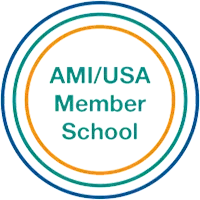Children's House
Overview
In Children's House, the child learns through curiosity, exploration, independence, and responsibility. The Children’s House classrooms consist of a vibrant community of 3- to 6-year-old children who work together and learn from each other every day. They transition from watching and learning from older mentors, to taking pride in being experienced leaders.
Children are free to choose work from the array of activities that the Guide has presented to them and to repeat that activity with
concentrated attention until their interest is satisfied. Children work and learn at their own pace as they manipulate a diverse array of developmental activities and engage with their peers as needed. This individualized approach to learning removes competition as a motivating factor and allows children to meet their
authentic needs, leading to the
development of self-direction and self-discipline, while building
social cohesion within the group. Each lesson that we show the child has specific aims that serve to satisfy their developmental needs. These lessons build on one another and integrate the experiences of the child. In our environment, there are endless opportunities for purposeful, hands-on work.
This highlight clip from our 'The Childpeace Experience' video shows Jennifer, a Toddler Community guide, talking about how our intentionally prepared environments allow children to follow their interests.
The Prepared Environment
Montessori classrooms are intentionally prepared environments where nearly everything is designed specifically to meet the child's developmental needs. It is the role of the Guide to connect the child to developmentally appropriate activities in the environment, and it is there that the child will teach herself. The furniture is of various sizes to fit the children's growing bodies, the shelves are low, the pictures on the wall are hung at the child's eye level, the water pitchers are small enough for growing hands, and the sponges are cut in half so a child can easily squeeze the water out. It is not just that the environment is "child-sized", but that the materials are functional for a child to use independently and with real purpose. There are cultural objects from around the world for the children to touch and explore, there are a variety of natural textures the children will feel as they use various materials, and there are fragile objects to handle. There are plants and animals to care for and places to daydream. The classroom offers opportunities to practice grace and courtesy.
The children also learn to
help others and
care for their environment. Materials are limited in number and only one of each activity is available. The children are never asked to share but to respect the work of others and to fully concentrate on their own chosen activity. When finished, the work goes back to the shelf ready for the next person. This is a much higher level of consideration than sharing.
Hands-on Work
During these years, children prefer activities they can engage in with their hands, work on at their own developmental pace and choose according to their interests. The children learn
social independence
by initiating and completing activities. Some of us may find it hard to imagine that a child can find anything but "play" enjoyable and absorbing. Yet we see that children feel great joy and wonder in the process of their "work", their engaging and purposeful activities. When children are allowed their natural spontaneity, they will choose to work and will work until they feel some sense of
mastery and satisfaction.
Areas of Activity
As an aid to the child's self-construction, individual work is encouraged. The primary areas of the curriculum in the Children’s House program are
Practical Life, Sensorial, Language, Cultural Extensions,
and Mathematics. All of which cultivate the children's ability to express themselves and think with clarity. Though each child is unique in ability and interests, the Guide will have an expectation of minimal accomplishment in each area as the child prepares to move up to elementary. The child has an unlimited possibility of accomplishment in each area as the Guide is trained with an expanse of curriculum that overlaps with the elementary.
Daily Schedule
| 7:30 - 8:30 AM | Early Morning Care |
|---|---|
| 8:30 - 11:30 AM | Montessori Work Cycle |
| 11:30 AM - 12:15 PM | Playtime |
| 12:15 -1:00 PM | Lunch |
| 1:00 PM | 1/2 Day Departures |
| 1:00 - 3:00 PM | Nap or Extended Day Work Cycle |
| 3:00 PM | 3/4 Day Departures |
| 3:00 - 5:30 PM | After School Care |
The goal of early childhood education should be to activate the child’s own natural desire to learn.
-Dr. Maria Montessori






